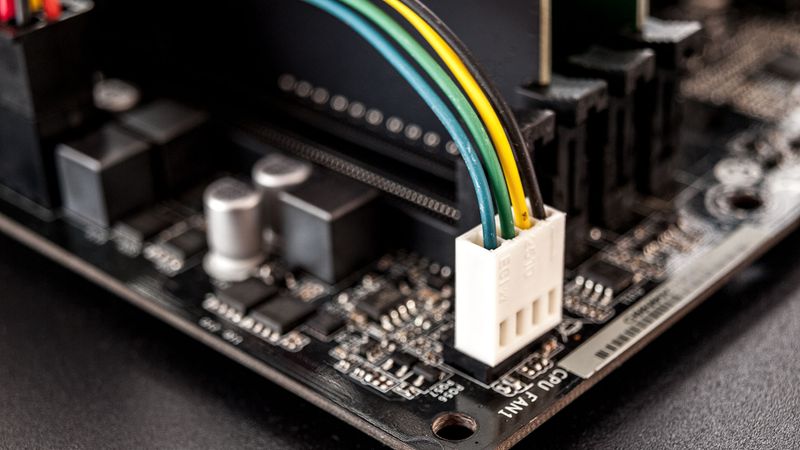Improved electrical interconnects for data centers with higher-power delivery and smaller-footprint
Article #1 of our Industrial IoT Revolution Series: As the power requirements and operating frequencies of electronic components rise, new interconnecting technologies are required to cater to the ever-growing demand.
This is the first article in a 6-part series featuring the connectivity technologies enabling the Industrial IoT revolution. The series introduces and explains the applications of wired and wireless interconnecting technologies in various industries. This series is sponsored by Mouser Electronics. Through their sponsorship, Mouser Electronics shares its passion for technologies that enable the continued sustainable growth of Industrial IoT.
Introduction
Internet of Things (IoT) devices rely on server and data center technologies as their backbone. A backbone that necessitates the utilization of a lot of power in progressively shrinking Printed Circuit Boards (PCBs). Having gone through a rapid expansion in recent years, the higher integration of power-hungry components and rise in the operating frequencies is driving PCB power requirements to new levels. Low voltage IC packages running at high speeds are creating the need for delivering hundreds of amperes of current to high-performance PCBs used in server and data center equipment.
In this article, we will explore the increasing need for advanced electrical interconnecting technologies for the growth of Industrial IoT. We will showcase some examples of the technologies by Amphenol Corporation that are at the forefront of the developments.
But before we get to that, let’s take a look at the data center power chain and understand the requirements of electrical interconnects.
The data center power chain
To power the Information Technology (IT) infrastructure and the cooling systems present within a data center, a reliable power supply is required. Transformers, Uninterruptible Power Supply (UPS), Switchgears, Power Distribution Units (PDU) are just some of the core components of the electrical supply system. These components need to be connected together systematically to achieve the desired functionalities.
The structures that enable the flow of power from one electrical contact to another are known as electrical interconnects and are an integral part of any electrical/electronic system.

Often power lines cannot be directly terminated to the PCBs; thus, wire systems are utilized. To complete the system assembly, one must find wire terminated connector components that meet power needs and offer routing feasibility in the often compact spacing of the housing. As mentioned earlier, high speed and high-density electronics have driven demand for significant increases in the amount of power needed for power to board applications. To cater to this demand, industries have developed a vast array of ‘Power to Board’ solutions to facilitate the distribution of power with higher amperage while allowing the design engineers to achieve size and weight reductions.
Meeting the data center interconnect demands with Amphenol
Conventional interconnects are limited in their ability to deliver high currents without consuming excessive board surface area. The next-gen Power to Board family of connectors incorporate a hyperbolic lamella socket contact construction that provides more contact surface area. The high-performance contact enables higher current carrying capabilities with lower temperature rises than traditional contact systems.
Amphenol’s RADSOK® Power to Board product line offers many options for delivering high current and single-point connections to the PCB. This product family includes PowerBlok™/PowerBlok™ WTB, RADSERT™, and the PGY™.
RADSOK® PowerBlok™ and PowerBlok™ WTB
PowerBlok™ WTB power connectors use patented RADSOK® contact technology to meet the increasing power requirements of printed circuit boards and the need for a smaller board footprint.
The RADSOK® PowerBlok™’has a compact footprint of ½” x ½” and can supply up to 70A to backplane power connections. The current is distributed over 16 compliant pins. PowerBlok™ is available for top or bottom entry and comes with a touch-proof cover.
RADSOK® PowerBlok™ Key Features:
- High power-to-board interconnect
- Compact footprint of 15.7mm x 15.7mm
- RADSOK® 2.4mm, 3.0mm & 3.6mm (35A-60A-70A)
- Backplane power interface with compliant pins for power delivery
- Touch-Proof cover
- Hyperbolic socket design ensuring many points of contact
- Reduced failure modes and burnouts
- Does not require special crimp tools and has no threaded fasteners
- Eliminates the possibility of stress fractures in board
- Higher throughput
- Super Twist (ST) technology for misalignment tolerance
- Restriction of Hazardous Substances Directive (RoHS) compliant
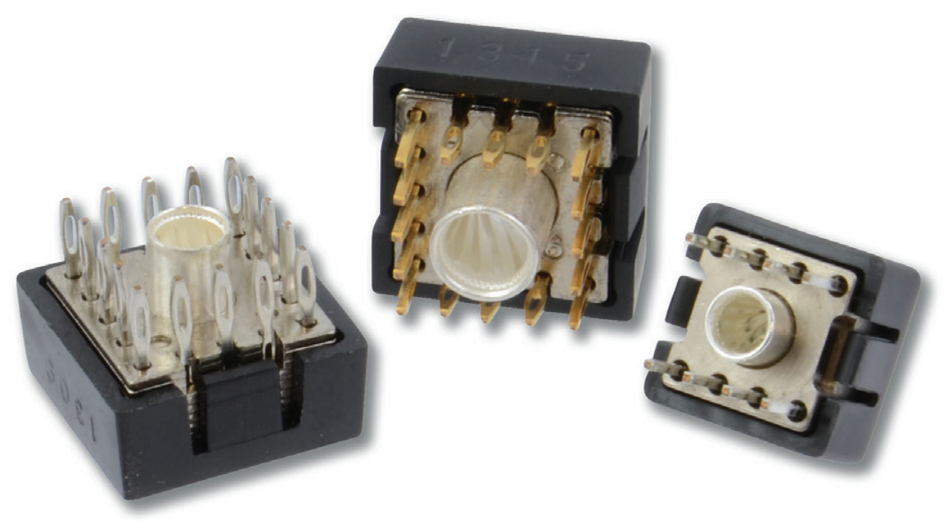
Offered in vertical or horizontal mating planes as two-point contact terminals, the WTB product line gives the versatility needed when component placement decisions are crucial. Supplied in easily automated tape and- reel packaging, the interconnect is designed as a pin through-hole placement commonly used in the industry. Integration is straightforward from design onset or as a component replacement. With the addition of a removable lock housing, mating to the board can remain intact even under harsh environments.
RADSOK® PowerBlok™ WTB Key Features:
- RADSOK® size 2.4mm or 3.6mm
- Current rating of 35-70A and voltage rating of up to 500V DC
- Low profile and impact footprint on PCB
- 6-8 American Wire Gauge (AWG) crimp contact with insulated latching housings
- Silver over nickel plating on the socket and pin
- Tin over nickel plating on crimp barrel and receptacle body
RADSOK® RADSERT™
RADSERT™’s footprint design can deliver up to 120A of current to the board. The high current density and small surface area connection provides the flexibility of board design. RADSERT™ contacts are available in either press-fit or solder termination.
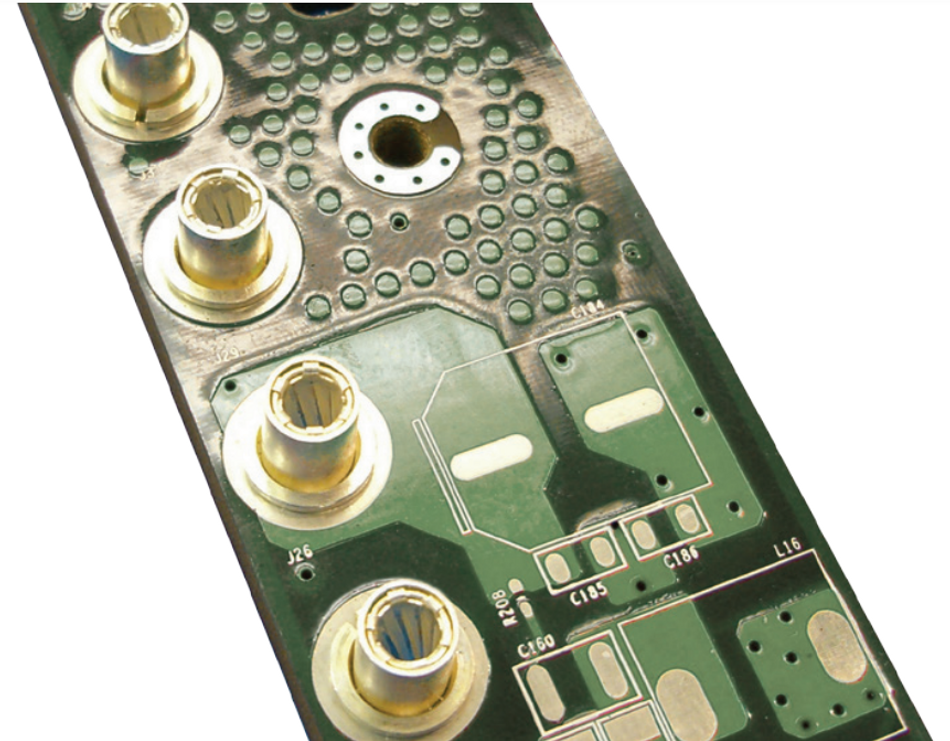
RADSOK® RADSERT™ Key Features
- RADSOK® size 2.4mm or 3.6mm
- Current rating of 35-70A and voltage rating of 500V DC
- Two points of contact
- Low profile and impact footprint on PCB
- 6-8 AWG crimp contact with insulated latching housings
- Silver over nickel plating on the socket and pin
- Tin over nickel plating on crimp barrel and receptacle body
RADSOK® PGY™
The RADSOK® PGY™ provides a compact and robust right-angle power to board interconnect. Designed to mate with either a 3.6mm or 5.7mm pin, The RADSOK® PGY™ can bring currents up to 120A to the board. The radial design of the RADSOK® contact gives more contact surface area lowering temperature rise and reducing potential heat-related failures.
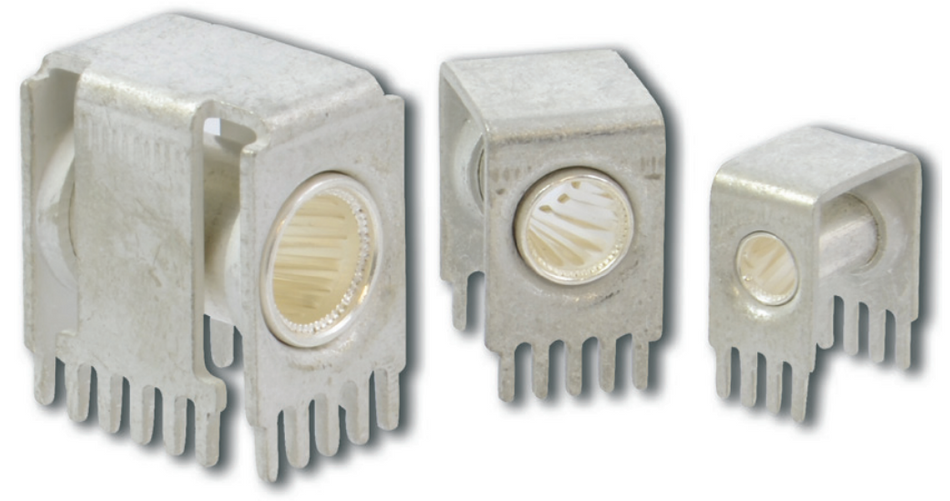
RADSOK® PGY™ Key Features
- Orthogonal, co-planar & right-angle connections between PCBs or PCB to bus bar
- Compact footprint
- Legs of the PGY distribute high power evenly
- Current ratings ranging from 35 A for 2.4 mm variant going up to 120 A for 5.7 mm variant
- No threaded fasteners
- No special crimp tools required
- Faster through-put
- Available in Super Twist (ST)
- RoHS compliant
Amphe-Phase™
Powering Server and Data Center environments require high-quality industrial plugs, receptacles, and Power Distribution Units (PDUs) to command their critical IT loads. The interconnect devices used need to be safe, secure, and reliable. The Amphe-Phase checks all of these boxes.
Amphe Phase connectors are designed to connect single & three-phase high current power circuits. They can deliver up to 800A in a single contact with touch-proof safety and an IP67 rating. The IP67 rating ensures that the product remains fully operational post-exposure to dust and liquids found in most industrial environments.
These connectors have been tried and tested in some of the harshest environments worldwide, from the oil fields of Canada to data centers in the Arctic Circle. Based on their technical capabilities, safety features, rugged construction, reliability, and quality, they are ideal for interconnecting electrical phases.
Amphe-Phase’s standard safety features include a secondary locking system which requires a key to unlock the connection. This is in addition to touch-proof electrical contacts on all connectors, which reduces the risk of accidental contact when the connector is live. Connectors are available in cable and panel mount formats with either crimp or screw contacts.
The Amphe-Phase connector’s contact design achieves its 800A continuous rating by utilizing an arrangement of 29 transfer bridges. Each transfer bridge is rated at 30A, giving a total of 870A per contact.
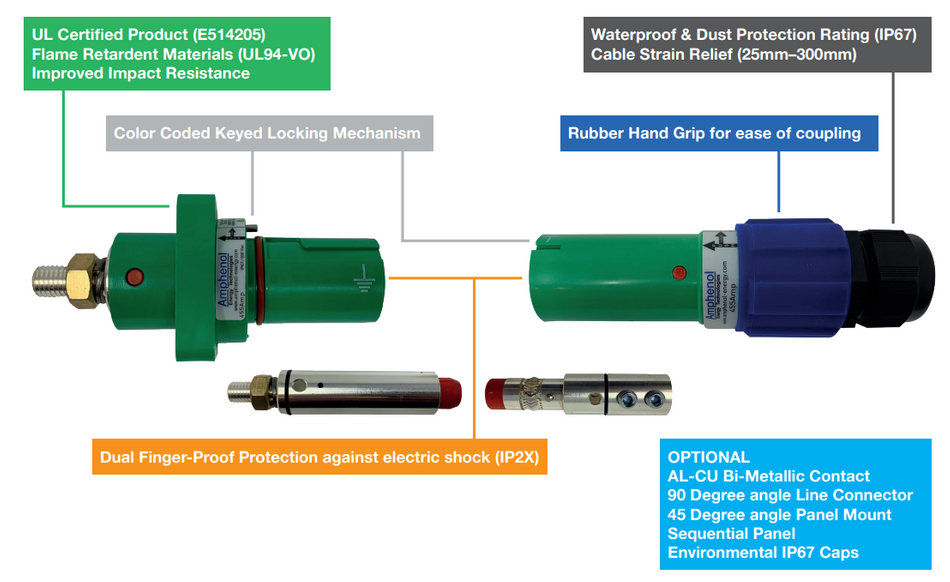
Amphe-Phase™ Key Features
- Maximum continuous current rating up to 800A*
- Surge current rating of 75kA
- Short circuit current rating of up to 35.5kA
- Cable cross-sectional area between 25mm² to 300mm²
- Screw or crimp contact termination
- Bayonet lock mating
- Operating voltage of 1000V AC
- Max rated voltage to earth: 2kV AC / 3kV DC
- Minimum flashover voltage: 9.5kV DC or AC peak
- Insulation resistance greater than 5M ohms at 500V DC
- IP67 protection*
- IP2X protection against electric shocks
- UL94-V0 plastic flammability standard
- Over 500 mating cycles
- Thermoplastic shell material
- Can withstand temperatures between -30°C to +125°C
- Silver-plated contacts
*Subject to environmental factors and cable choice etc. **In accordance with EN60529.
RADLOK™
RADLOK™ is a single-pole power interconnect technology designed to be a low-cost, compact, and robust solution for server, data center, and energy storage requirements. The wide range of RADLOK™ configurations allows for up to 1000V DC at current levels ranging from 70A to 500A utilizing 10mm2 to 150mm2 cables.
With an integrated, simple positive mechanical lock/release feature, the RADLOK™ product line provides low insertion and extraction forces while maintaining high retention forces and mating cycle ratings essential for volume production or high mating cycle applications.
The quick connect and single finger press-to-release lock feature reduces human error and replaces the tools/hardware associated with standard lug terminals during their assembly and maintenance. Mating pins and receptacles are available for busbar/PCB and panel mount feed-throughs with lug, thread, and mating RADLOK™ pin configurations.
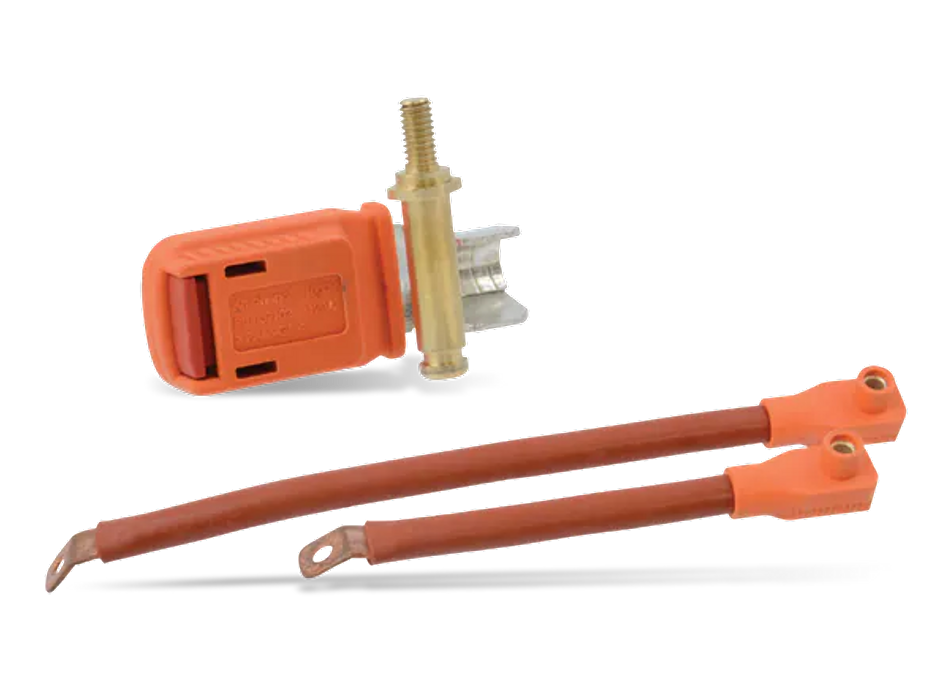
RADLOK™ Key Features
- Voltage rating of 1000V DC and current rating of 70A – 500A
- Mating cycle: 500 min
- Operating temperature range: -40°C + 125°C
- UL94 V0 plastic flammability standard
- Available RADSOK® sizes: 3.6mm-14.0mm
- Cable cross-sectional area ranging from 10mm² to 150mm²
- Hex crimp contact termination
- Single piece molded plug (no assembly required)
- Single-piece solid pin or feed-thru with grommet
- Audible click when mating, push to release
- Available in black, red, orange, and custom colors
- Silver plating
- RoHS and REACH Compliant
- UL1977 and IEC 61984 certification (select sizes)
Conclusion
Power handling and conversion equipment need to undergo continuous improvements to keep up with the evolving IT infrastructure. Developments in electrical interconnects, along with several other connectivity technologies, are proof that the Industrial IoT revolution has already begun.
This article was initially published by Mouser and Amphenol in an e-magazine. It has been substantially edited by the Wevolver team and Electrical Engineer Ravi Y Rao. It's the first article of a 6-part series examining connectivity technologies enabling the Industrial IoT revolution. Future articles will introduce readers to some more interesting applications of connectivity technologies in various industries.
Article one explained how electrical interconnects are engineered in data centers to deliver high power in a small footprint.
Article two was about the sensing technologies used in Building Automation Systems
Article three analyzed the key trends and challenges for connectivity technologies used in smart manufacturing.
Article four provided an overview of electrical interconnects for harsh environments.
Article five explored the connectivity technologies used at construction sites.
Article six examined the applications and performance parameters of antennas that enable wireless communication.
About the sponsor: Mouser Electronics
Mouser Electronics is a worldwide leading authorized distributor of semiconductors and electronic components for over 1,100 manufacturer brands. They specialize in the rapid introduction of new products and technologies for design engineers and buyers. Their extensive product offering includes semiconductors, interconnects, passives, and electromechanical components.

